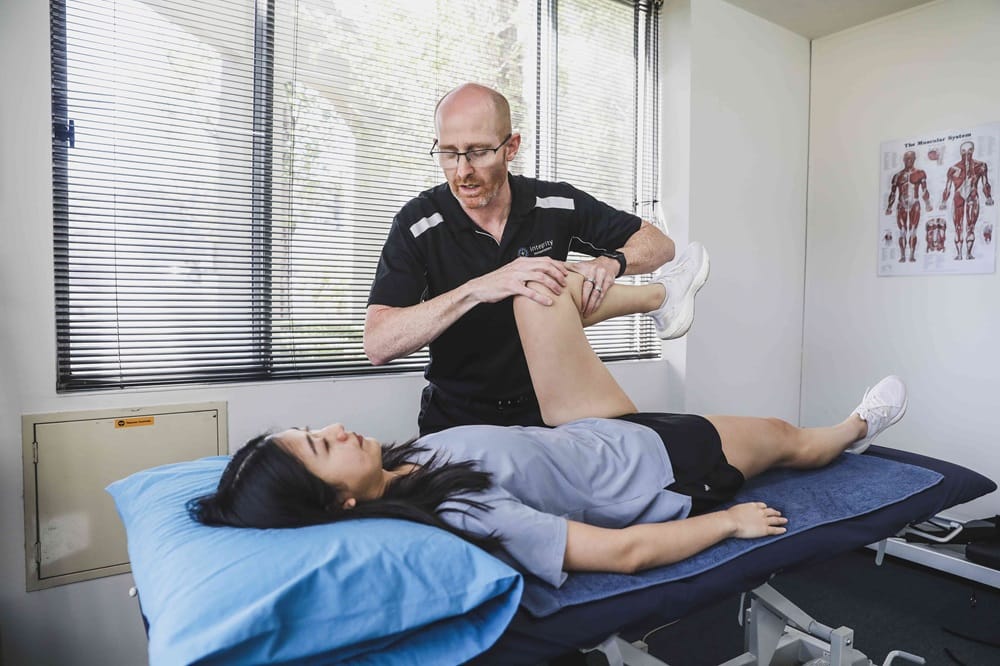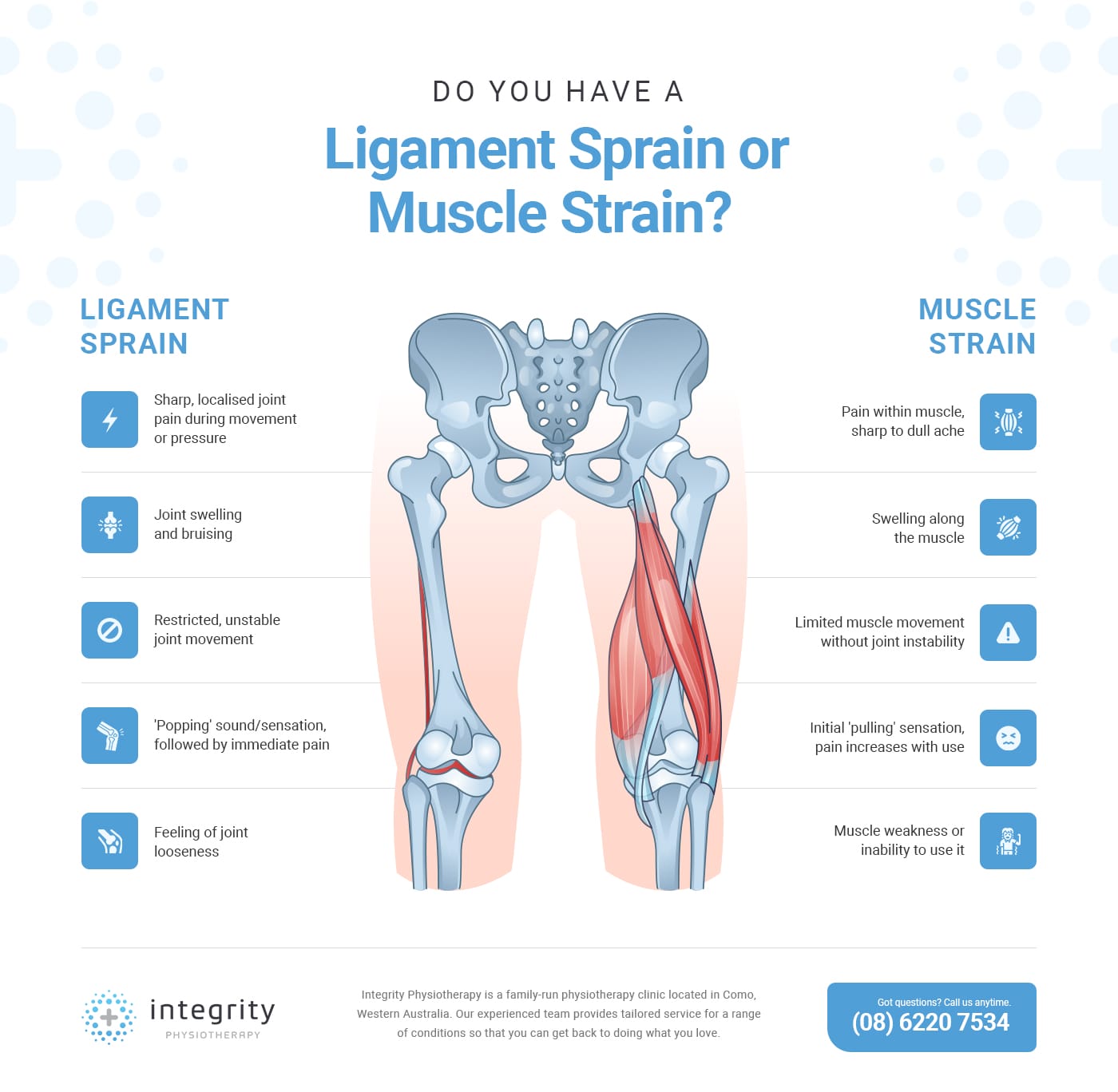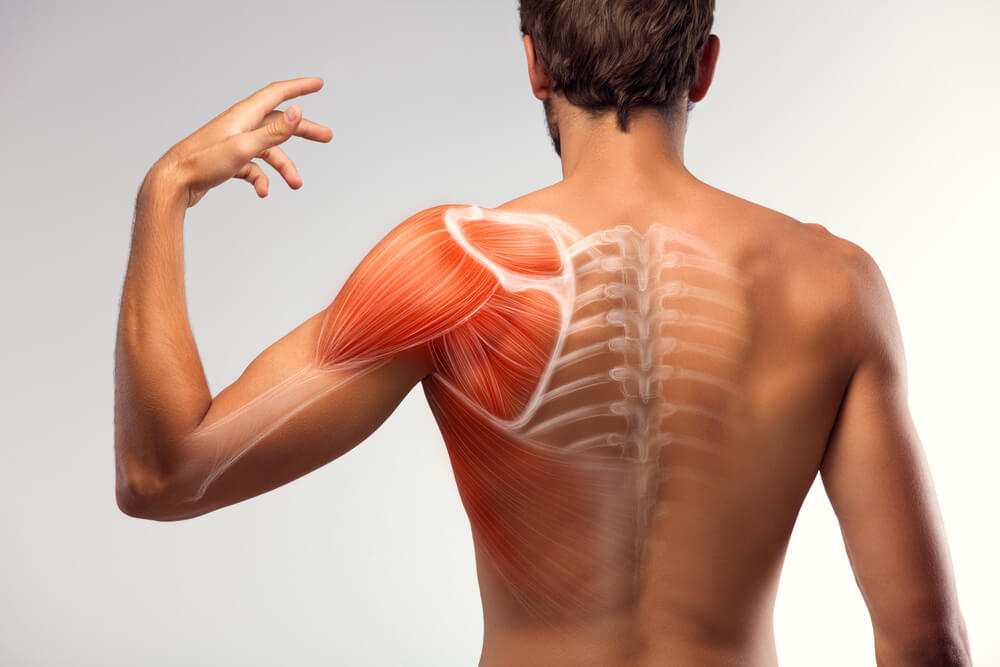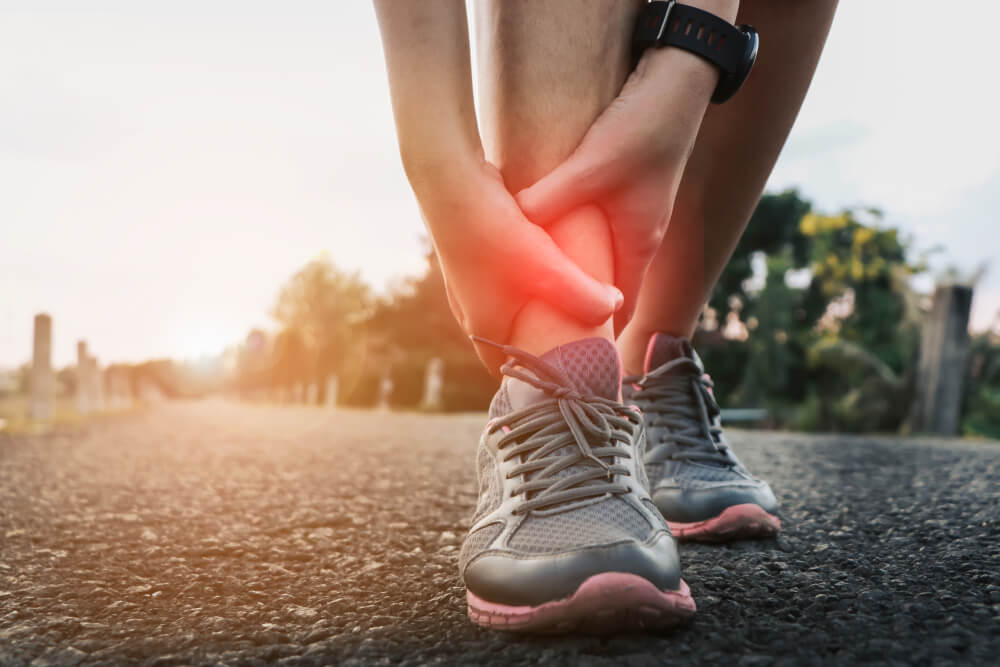
The difference between muscle sprains and muscle strains is often shrouded in a bit of confusion. Many of us casually use both terms interchangeably, without fully understanding what each injury entails. And that’s fair enough — they sound very similar!
A sprain is an injury to the ligaments, the tough bands that connect bones at a joint, while a strain refers to damage to muscles or tendons, the cords of tissue connecting muscles to bones. The confusion often stems not just from their names, but also because they can occur in similar situations, like sports injuries, physical activities, or even everyday movements gone awry.
What is a muscle sprain?
The term ‘muscle sprain’ is actually something of a misnomer because the injury it refers to doesn’t actually involve the muscles at all. In reality, a sprain is an injury to the ligaments, which are the strong fibrous bands responsible for connecting bones at a joint. These ligaments are essential for stabilising and supporting your joints, allowing for smooth and controlled movements.
A ligament sprain will typically occur when there’s a sudden wrench or twist applied to a joint, forcing the ligaments to stretch beyond their normal range of motion. This excessive force can cause the ligaments to stretch excessively or, in more severe cases, tear. Common sites for these injuries include the ankles, wrists, and knees — joints that are often subjected to twists and turns in everyday movement and physical activities.
What is a muscle strain?
Muscle strains, in contrast to a sprain, directly affect the muscles or tendons, which are the robust, fibrous tissues that anchor muscles to bones. This type of injury typically arises when a muscle or tendon is pushed to its capacity, either through overstretching or overexertion. This places undue strain on these tissues, leading to varying degrees of tearing within the muscle or tendon fibres.
Muscle strains are common in both everyday activities and during physical exercise, particularly in actions that suddenly stretch the muscles too far or exert an excessive amount of force. For instance, lifting a heavy object improperly can strain the muscles in the back, or, making a sudden, explosive movement during sports can overstretch a muscle in the thigh, such as a hamstring.
How to tell whether you have a ligament sprain or muscle strain
Telling the difference between a ligament sprain and muscle strain can often be tricky, and requires an understanding of the nature of each injury and recognising their distinct symptoms. Here’s how you can differentiate between the two.
Location of pain
- Ligament sprain: pain is localised around the joint (e.g. ankle, knee, wrist) because ligaments connect bones at the joints.
- Muscle strain: pain is within the muscle or at the point where the muscle connects to a bone, as strains affect the muscles and tendons.
Type of pain
- Ligament sprain: this pain often feels like a sharp pain at the joint, particularly when trying to move or put pressure on it.
- Muscle strain: this pain can be a sharp sensation initially, particularly when using the muscle, but often turns into a dull ache as time goes on.
Swelling and bruising
- Ligament sprain: swelling is usually more pronounced around the joint, and bruising can occur.
- Muscle strain: swelling can also occur, but it’s typically along the length of the muscle; bruising may appear later and can spread down the muscle.
Range of motion
- Ligament sprain: joint movement is often more severely restricted and can be accompanied by instability in the joint.
- Muscle strain: while movement can be limited due to pain, there’s generally no joint instability unless a major muscle is involved.
Onset of symptoms
- Ligament sprain: a ‘popping’ sensation or sound is often reported at the time of injury, followed by immediate pain and swelling.
- Muscle strain: a ‘tearing’ feeling may be experienced, with pain intensifying during muscle use.
Functionality
- Ligament sprain: there may be a feeling of looseness in the joint, especially if the ligament is severely torn.
- Muscle strain: weakness or inability to use the muscle is a common symptom.

Ligament sprain treatment
RICE therapy
The initial approach for a ligament sprain is RICE therapy: Rest, Ice, Compression, Elevation. Applying ice to the affected area can help reduce swelling and alleviate pain; it’s typically recommended to ice the injury for about 20 minutes every few hours during the first 48 hours. Compression, using bandages or wraps, can provide additional support and help manage swelling. Elevation of the injured area above heart level further aids in the reduction of swelling.
Pain relief
For pain relief, over-the-counter pain relievers like ibuprofen can be effective. If you’re dealing with a severe sprain or you’re in a significant amount of pain, make sure you get medical attention and follow the advice of your healthcare provider.
Physiotherapy
Depending on the severity, your doctor might also recommend physiotherapy to strengthen the surrounding muscles and restore the joint’s functionality. Your physio can help with a range of things, including:
- Pain management
- Improving range of motion
- Strengthening exercises
- Balance and proprioception training
- Functional training
- Education and prevention strategies
- Tailored recovery
- Manual therapy
- Use of bracing or taping
- Monitoring progress
Muscle strain treatment
RICE therapy
Much like a ligament sprain, you’ll want to start your recovery with the RICE protocol. Rest is crucial to prevent further injury and allow the healing process to begin. Apply ice within the first 24-48 hours to reduce swelling; aim for 20 minutes at a time, several times per day.
Physiotherapy
As your muscle begins to heal, gentle stretching exercises, as recommended by a healthcare professional, can help restore flexibility. In more severe cases, your physiotherapist can guide your rehabilitation process and prevent chronic problems.
Your physio can help with:
- Personalised rehabilitation programs
- Pain management
- Guided exercise therapy
- Improving flexibility
- Strengthening surrounding muscles
- Education on proper techniques
- Functional training
- Manual therapy
- Taping or bracing
- Preventative strategies
How to prevent sprains and strains
Whether you’re looking for ways to prevent ligament sprain or muscle strain, these measures apply to both, and are just good practice in general!
- Proper warm-up: before engaging in any physical activity, perform a thorough warm-up to increase blood flow and flexibility in the muscles and joints.
- Strength training: strengthening muscles, especially those around vulnerable joints, provides better support and reduces the risk of sprains and strains.
- Flexibility exercises: regular stretching helps maintain muscle elasticity and joint mobility, which can prevent injuries.
- Correct technique: whether in sports or daily activities, using the right technique is crucial to avoiding undue stress on your muscles and ligaments.
- Wear appropriate footwear: shoes that provide good support and fit well can significantly reduce the risk of ankle and knee sprains.
- Avoid overexertion: listen to your body and avoid pushing it beyond its limits. Gradually increase the intensity and duration of your activities.
- Stay hydrated and well nourished: proper hydration and nutrition help maintain muscle and joint health, reducing injury risk.
- Use protective gear: in certain sports or activities, use recommended protective gear like ankle braces or knee supports.
- Regular physical activity: maintaining a regular exercise routine keeps muscles and ligament conditions less prone to injury.
- Rest and recovery: ensure adequate rest between intense physical activities and allow muscles and ligaments to recover.
Don’t let sprains and strains hold you back
Understanding the differences between sprains and strains is pivotal in managing these common injuries effectively. By implementing preventive measures and knowing how to respond when an injury occurs, you can keep your muscles and ligaments healthy and resilient.
If you’re in a bit too much pain or you’re dealing with repeat injuries, professional guidance is key. Don’t let an injury hold you back — get tailored muscle strain treatment and recover safely.



